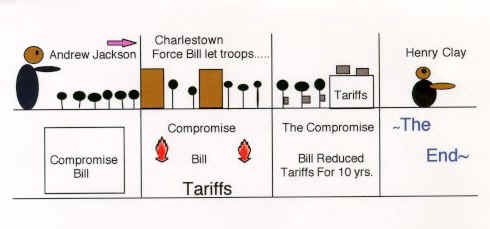
Topic: Nullification

Topic: Nullification
| Table of Contents | |
| Overview
Vocabulary Terms and Identifications |
Important
Chart
Biographies of Key Historical Figures |
|
|
|
Overview:
In 1828 Congress passed a high tariff act which favored the industrial north.
Another tariff was passed in 1832, even though
the tariff act of 1832 was slightly easier than
the tariff of 1828. South Carolina declared the tariff of 1828 and 1832 null and
void. The state threatened to secede, or leave the Union if the government tried to collect
duties.
On December 10,1832 Jackson ordered
troops and warships to be sent to Charleston. He felt that the action by South
Carolina to refuse to pay the tariff of 1928 was treason. The Force bill he
rammed through Congress allowed him use the armed forces to collect
tariffs. To prevent use of federal troops against South Carolina, Senator Henry Clay passed through a compromise tariff bill
that would be in effect for
ten years.
South Carolina immediately called a convention that
passed a law of nullification forbidding a collection of tariff duties
in the state. Nullification was a political doctrine holding
that a state might reject or nullify any federal law that it was considered
unconstitutional. The idea of nullification influenced southern
political thought about states rights and helped clear the way for secession at
the time of the Civil War. The rise of states' rights theory in the South
was made especially strong due to the rise on the importance of cotton in the
South's economy during the early 1800s. Nullification was justified in the 1830s
when southerners charged the Tariff Act not was only discriminative
in term but was thought of as being unconstitutional.
Vocabulary and Identifications
1) Nullify To declare that a certain law will not be enforced.
2) States Rights: the idea that states may nullify federal laws if they are found to be unconstitutional.
3) Force Bill Gave power to Jackson to use the army and navy to enforce the Tariff of 1828.
4) John C. Calhoun Vice President and supporter of keeping the Union along with states' rights.
5) Tariffs Taxes on imports, especially manufactured goods from England.

Flow Chart: The Nullification Crisis of 1832
Biographies
of Important People
| John
C. Calhoun
John C. Calhoun was a man of great ambition,
he ran for president in 1824. After losing to Jackson he withdrew
for vice-president. At the time of the election for vice-president
he wasn't seen with a states' rights position. But his views were
changing inspired by the cotton cultivation, which was dependent on slavery.
|
Andrew
Jackson
The
Tariff Act threatened to leave the Union if the government tried to collect
duties at Charleston. Senator Henry Clay had a compromise bill that
reduced all tariffs for ten years. South Carolina took out its nullification
of the tariff but declared a forced law. But this did not settle
the nullification issue. Nullification angered Andrew Jackson.
On Dec. 10,1832 Jackson ordered troops to march to Charleston.
|
1. Who was president during the Nullification Crisis?
2. Who authored South Carolina Exposition and Protest in 1828?
3. Who ran for President in 1824 but lost to Andrew Jackson?
4. John C. Calhoun changed his opinion about following federal law because of the cultivation of what crop that was dependent on slaves?
5. Who wrote the Compromise Bill that reduced tariffs for ten
years?
1. Andrew Jackson
2. John C. Calhoun
3. John C. Calhoun
4. Cotton
5. Henry Clay
Resources: Academic America Encyclopedia
The American Revolution - an .HTML project. 1997.
All rights reserved. Department of
Humanities Computing
[WWW] Available: http://odur.let.rug.nl/~usa/H/1994/ch5_p5.htm
Student authors:
Michael L.
George Cassutto's Cyberlearning
World
[Lesson Plan of the Day] [Cassutto Memorial] [About the Author] [Search] [Civics Lesson Plans]